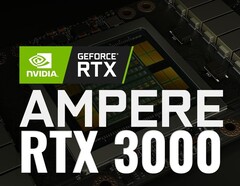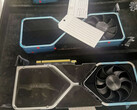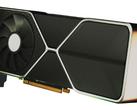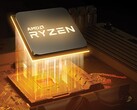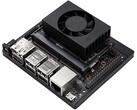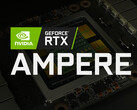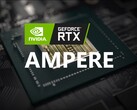With only a few days remaining until the official reveal of the RTX 3000 Ampere-based gaming GPUs from Nvidia, the rumor mill is getting busier than ever. We have seen some Ampere specs thrown around in the past few months, but nothing comes close to what Tom from Moore’s Law is Dead has recently compiled in his latest video. For the first time, we get detailed specs for the RTX 3080 Ti cards themselves, as well as projected performance gains over the Turing cards, plus some more details on how AMD’s RDNA2 GPUs will fare against the Ampere models.
As far as card specs are concerned, the Founder’s Edition variants of the upcoming RTX 3080 Ti are expected to come with a triple-fan cooler and a simplified design with fewer screws on the back. Since the high-end GA102 SKU will be manufactured on the 7 nm EUV node from TSMC, the power draw should be lower in comparison to Turing GPUs, so the high-end cards supposedly feature only two 8-pins connectors instead of three. Tom points out that we could see some custom designs that make use of three connectors for increased overclocking potential later on. As expected, all Ampere cards are getting PCIe 4.0 X16 support, and the RTX 3080 Ti in particular will get 3x DisplayPort 2.0 + 1x HDMI 2.1 video outputs that support up to 10K resolutions. Additionally, there will be an USB-C port.
Unfortunately, the exact core counts, die sizes and memory capacities are still unclear for the Ampere SKUs. Tom does have most of the specs for the GA102 SKU (RTX 3080 Ti), though. According to Tom's sources this high-end version will integrate 5,376 CUDA cores and will have a 220-230 W TGP. Boost clocks could go beyond 2.2 GHz leading to a total raw performance of 21 TFLOPS. The high-end cards are supposed to come with 18 Gbps GDDR6 VRAM, which theoretically leads to a 40.3% bandwidth increase over the RTX 2080 Ti model.
Estimated rasterization performance gains over the current Turing cards are ranging between 40% and 70% in 4K resolutions, which would make the current RTX 2080 Ti as fast as the upcoming mid-range RTX 3060. Even with estimated 10% IPC improvements, average gains should be around 50% across the entire family, but some more poorly optimized games may show only 40% improvements, while other games specifically optimized for Nvidia cards could perform up to 70% faster. Tom mentions that the GA103 and GA104 SKUs (RTX 3070 and 3060, respectively) are rumored to boost to 2.5 GHz, but may end up hitting massive CPU bottlenecks at 1080p and 1440p resolutions.
When it comes to ray tracing improvements, the Ampere RT cores are said to process intersections 4 times faster than the Turing RT cores. However, the RT core count itself will not necessarily change. Even the low end Ampere GPUs will feature RT cores (MX550 included), and we could expect to see these cards performing faster than high end Turing models when activating ray tracing effects due to the inclusion of additional SMs, L2 Cache and doubled Tensor core count. As an example, the GA102 proved to be 4-5 times faster than the Titan RTX in Minecraft RTX.
Other features releasing with the Ampere GPUs include DLSS 3.0, NVCache, Tensor Memory Compression, improved RTX Voice and 7th gen NVENC supporting 8K@60 for H264 and H265 codecs. The DLSS 3.0 update should further simplify driver implementations per specific game and bring solid fps gains, while the NVCache feature will be working in tandem with the system RAM and SSD for enhanced load times similar to how next gen consoles get a bandwidth boost from the NVMe SSDs. Thanks to the new Tensor Memory Compression feature, 12 GB cards could behave like 16 GB cards with minimal performance loss.
Regarding the release dates for the new Ampere GPUs, it looks like the HPC models are expected to be available in late May, while consumer gaming GPUs will only be available this September, which might give AMD a small advantage with the RDNA2 cards expected to launch mid-year.
Speaking of RDNA2 performance, Tom’s sources claim that the Big Navi GPUs early samples proved to be only 10% faster than the RTX 2080 Ti, but those samples were clocked like mobility cards, so the actual performance of the Big Navi GPUs could match the high-end Ampere cards with proper core clocks. This might prompt Nvidia to rush an Ampere-based Titan RTX card just to claim the performance crown. RDNA 2 will also be proficient at Machine Learning tasks, possibly providing competition for Nvidia's compute-oriented GPUs.
Tom concludes that 2020 will probably be the most competitive year in regards to gaming GPUs and we could see some serious price wars by the end of the year.
I first stepped into the wondrous IT&C world when I was around seven years old. I was instantly fascinated by computerized graphics, whether they were from games or 3D applications like 3D Max. I'm also an avid reader of science fiction, an astrophysics aficionado, and a crypto geek. I started writing PC-related articles for Softpedia and a few blogs back in 2006. I joined the Notebookcheck team in the summer of 2017 and am currently a senior tech writer mostly covering processor, GPU, and laptop news.
> Expert Reviews and News on Laptops, Smartphones and Tech Innovations > News > News Archive > Newsarchive 2020 05 > Nvidia GeForce RTX 3080 Ti specs and performance figures leaked, AMD "Big Navi" performance comparison also included
Bogdan Solca, 2020-05-12 (Update: 2024-08-15)




